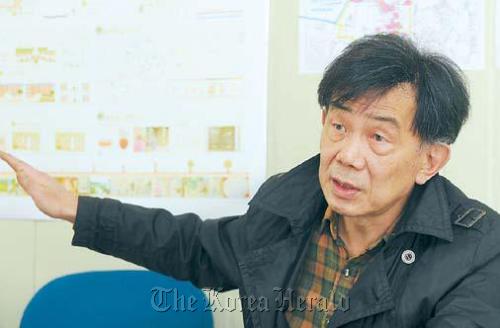
Local community calls for cancellation of redevelopment plan near Joseon royal tomb Jeongneung
In Jeongneung-dong, northern Seoul, there is a residential area made of some 80 low-rise houses ― a rare sight in the city where apartment complexes dominate the landscape.
The residential community, formed in the late 1960s by university professors, is located near one of Seoul’s UNESCO World Heritage Sites ― Jeongneung. The royal tomb, where Joseon founder Taejo’s second consort Queen Sindeok (?-1396) was buried, is recognized for its serene and scenic beauty in harmony with its natural surroundings.
The residential community has been facing a new challenge since 2008, when a redevelopment plan of the area, which consists of building a 770-unit apartment complex, was announced. That year, some 50 people in the community formed an organization with the aim of keeping their homes and protecting the royal tomb from being surrounded by “big and tall concrete structures.”
In Jeongneung-dong, northern Seoul, there is a residential area made of some 80 low-rise houses ― a rare sight in the city where apartment complexes dominate the landscape.
The residential community, formed in the late 1960s by university professors, is located near one of Seoul’s UNESCO World Heritage Sites ― Jeongneung. The royal tomb, where Joseon founder Taejo’s second consort Queen Sindeok (?-1396) was buried, is recognized for its serene and scenic beauty in harmony with its natural surroundings.
The residential community has been facing a new challenge since 2008, when a redevelopment plan of the area, which consists of building a 770-unit apartment complex, was announced. That year, some 50 people in the community formed an organization with the aim of keeping their homes and protecting the royal tomb from being surrounded by “big and tall concrete structures.”


“Most of the people in this area have been living in their single-unit houses for more than 30 years,” said Nyung Kwon, president of the group “Jeongneung Neighbors.”
“We have our sentimental attachment to our individual homes as well as Jeongneung. The tomb is recognized not only for its shape, but its harmony with the nature. It reflects Korea’s traditional feng-shui principle and geomancy, where laws of heaven and earth, as well as the harmony with the nature are considered important. Having a large-scale apartment complex would just ruin the very spirit of this site.”
The group filed a lawsuit against the municipal government of Seongbuk-gu and redevelopment union, claiming it is against the law to proceed with a redevelopment project with which less than 75 percent of the population of the area consent. They won the case last year.
The redevelopment union, in turn, repeatedly filed a claim with the state-run Cultural Heritage Administration, asking for an approval to build the apartment complex near the royal tomb.
In response to this, Jeongneung Neighbors sent a formal letter of request to Kishore Rao, director of UNESCO’s World Heritage Center, asking for his attention to the case.
Rao wrote back to Kwon, Jeongneung Neighbor’s president, last month, saying UNESCO has asked the Cultural Heritage Administration for clarification, as well as the International Council on Monuments and Sites (iCOMOS) for information. Upon receiving the clarification request from UNESCO, the Cultural Heritage Administration deferred making a decision on the redevelopment plan.
“The worst that can happen is Jeongneung being deleted from the World Heritage List,” said Hwang Pyong-woo, director of the Korea Cultural Heritage Policy Research Institute, who has been supporting Jeongneung Neighbors in their campaign to stop the redevelopment plan.
“What makes me angry is why does UNESCO have to get involved in this matter? Why can’t the Cultural Heritage Administration actually listen when NGOs and the residents have something important to say about our historical relics and heritage?”
So far, two international sites have been deleted from the World Heritage List. The Dresden Elbe Valley in Dresden, Germany, lost its UNESCO world heritage title after a four-lane bridge was built in 2009 as the U.N. agency decided the bridge seriously damaged the integrity of the property’s landscape.
However, Cho Hyo-sang of the Cultural Heritage Administration’s International Affairs Division said it is very unlikely that Jeongneung would lose its UNESCO designation.
“We are currently preparing a report to submit to UNESCO,” said Cho. “There was no specified deadline to respond.“
By Claire Lee (dyc@heraldcorp.com)

















![[KH Explains] Hyundai's full hybrid edge to pay off amid slow transition to pure EVs](http://res.heraldm.com/phpwas/restmb_idxmake.php?idx=652&simg=/content/image/2024/04/18/20240418050645_0.jpg&u=20240419100350)

![[Today’s K-pop] Zico drops snippet of collaboration with Jennie](http://res.heraldm.com/phpwas/restmb_idxmake.php?idx=642&simg=/content/image/2024/04/18/20240418050702_0.jpg&u=)